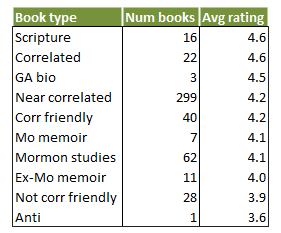I wrote a post a couple of years ago where I looked at how Mormon-related movies were rated on IMDB. I thought it would be fun to do a similar look at how Mormon-related books are rated on GoodReads.
I got ratings for 568 books, mostly Mormon-related, but with a few others for comparison. The Mormon-related ones were scriptures, Church-published materials like manuals, and books by GAs, Mormon studies people, and popular Mormon authors (e.g., Jack Weyland, Anita Stansfield). The non-Mormon ones were a few Bibles, the Left Behind series, the top 10 fiction and non-fiction books on the GoodReads lists (I’m not sure exactly of the criteria for these), and 20 fiction and 20 non-fiction books I was hoping would be more representative of average books, so I chose them off of GoodReads user-created lists that had nothing to do with the book content (one was strange titles and the other was interesting covers). I required a book to have at least 50 ratings to be included, although I made exceptions for three extra bad ones I was interested in: the ERA-era book Woman, written by a bunch of GAs, the priesthood/temple-ban-justifying Mormonism and the Negro, and the mansplained classic Woman and the Priesthood. Note that I’ve gathered this data in bits and pieces over the last month or so, so some of the numbers might be a little out of date.
I assigned the books to categories depending on how Correlation-friendly they were. Unfortunately, I’ve only read a small fraction of the books, so I didn’t have firsthand knowledge in most cases. However, most books make pretty clear what type they are. For example, Mormon studies books are typically published by university presses. More correlated books are typically published by Deseret Book or Shadow Mountain. Anyway, this table shows, for all the Mormon books, the number of books in the sample and their average rating on the 1-to-5 scale used by GoodReads.

In my post on movies, I speculated that there would be higher ratings for movies produced by the Church, or that were scripture-adjacent, and that did turn out to be the case. It looks like there’s a similar pattern here, as scriptures rate the highest, and generally categories rank lower in average rating as they move further from being correlated. Here’s a brief explanation of what falls into each category:
- Scriptures — LDS scriptures in different forms (e.g., Book of Mormon separate vs. Triple Combination) plus some non-LDS editions of the Bible.
- Correlated — Church manuals and books that have essentially become manuals (e.g., Jesus the Christ).
- GA biography — Biographies of GAs.
- Near correlated — Nearly all books by GAs, as well as books by people like John Bytheway who are striving to be correlated, and novels by writers with similar goals (Gerald Lund, Chris Heimerdinger).
- Correlation friendly — Books that aren’t quite trying to be correlated, but are still very Church-friendly, like many of the Givens’s books, Hugh Nibley, and some of Patrick Mason’s.
- Mormon memoir — Memoir of someone who’s still Mormon (e.g., Leonard Arrington’s Adventures of a Church Historian).
- Mormon studies — Any look at a Mormon topic from a scholarly perspective, so for example Maxine Hanks’s Women and Authority, or John Turner’s biography of Brigham Young, or Kathleen Flake’s book about the seating of Reed Smoot in the US Senate.
- Ex-Mormon memoir — Memoir of someone who left Mormonism, regardless of hostility level, so everything from Martha Beck’s Leaving the Saints to Katie Langston’s Sealed.
- Not correlation friendly — This includes books with ideas that GAs would generally frown on, even if the writers aren’t hostile to the Church, so for example anything by Carol Lynn Pearson that’s too kind to gay people or too open to Heavenly Mother or rejecting polygamy.
- Anti — The only book I got in this category is Ed Decker’s classic The God Makers.